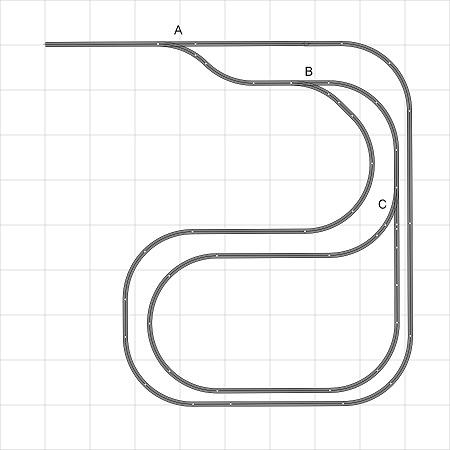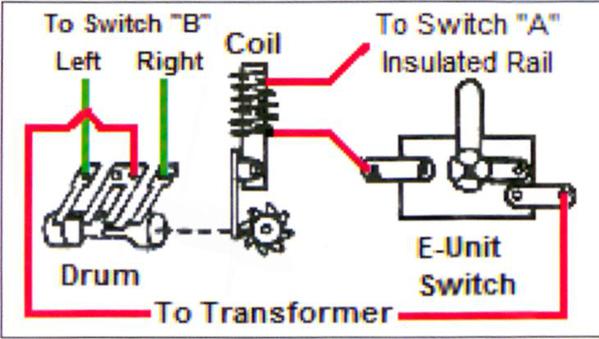I guess I should start with a little background. Like the majority of us I have limited space for a layout.
That being said I wanted to get the most out of what space I have.
I also don't care for my trains just going one direction on a loop of track.
The last thing, I just like to sit back and watch my trains run. The most effort
I make is blowing the whistle.
On to the layout. My layout can best be described as 2 reversing loops with
a connecting piece in the middle. The part I want to concentrate on is on
the diagram below. A reversing loop within a reversing loop.
It's only half of the layout, but you get the idea. I wanted to ( and did ) wire all
the switches for non-derailing. ( just sit and watch remember ? ).
Now the challenge. It's all works fine, but how do you automate switch "B" to
send the train into the loop served by switch "C" ?
Talking to other people in the hobby I was told that an odd number of switches
was my hurdle. Mmmm track is already laid, Must be some other way to do this.
Everything seemed to revolve around switch "B" . When do I throw the switch ?
I played with the idea of triggering it through switch "A". Then again after is passes switch "B".
I came close, I could get it into switch "C" but got stuck in the inner loop.
Well I narrowed it down to knowing the direction of the train from switch "A" to
Switch "B". So If I know the direction of travel I can then add a flip-flop
type of circuit to alternate switch "B".
The train is at the top going from left to right. It turns through switch "A" and heads towards switch "B". The train is heading left to right.
Ok, lets throw switch "B" to straight. Great, now I am in the
inner reversing loop. The train now returns through switch "B" and outbound to
switch "A". When it returns to switch "A" it's still thrown, so I'm headed back
towards switch "B" again left to right direction. So lets throw switch "B" to curved.
Now I am in the outer reversing loop. lets go around and end up outbound
through switch "A". On the return trip we are now straight through switch "A".
Back through switch "B" heading right to left. I don't want the switch to throw
now. Again outbound through switch "A". upon returning switch "A" now sends the train back to switch "B".
It's headed left to right again. Lets throw switch "B"
and send it back to the inner loop.
Mmmm in my head and on paper it works.
So the key is to determine the direction of the train. Lets see. 2 isolated rails
in series with some relays. How about a couple dwarf signals and relays, They
look cute. I spent a lot of time on this and could not come up with anything.
Nothing simple anyway. I could always get it to work in one direction but
not the other.
This flip-flop direction thing was driving me nuts. Then while doing some
repairs on an engine I saw a possible solution. the E unit.
Lets see. It reverses the motor by energizing one motor brush and then
the other. Hey it's a flip-flop circuit with a neutral position.
1st try. I purchased an electronic E unit and went to work. First thing was to take
switch "B" and disconnect the switch motor so that the E unit could control it.
What would control the E unit ? The isolated turn out rail on switch "A"
My other problem was that the E unit only switches the + or power side of the
motor. I didn't have a frame for ground. So looking around on the board I found
my ground point. Still switching the positive though. Ok Add a couple relays.
One to open the switch, one to close it.
The other thing I did and always do, was to add a DC relay to control the E unit.
Let me explain. I tap into the AC track, go through a rectifier and convert it to DC
to feed a DC relay. On the relay coil I put a 470uf capacitor to hold the relay energized for a second or two after the train passes.
When dealing with track and isolated rails things always get dirty.
So to over come this the capacitor prevents the relay chatter the comes from dirty track and wheels.
So on to the electronic reversing unit. With everything hooked up it was time to test.
Here comes the train, isolated relay energizes the E unit. Relay is triggered switch
is thrown. YES.... ok , through the loop, out switch "A", around the left side of the
layout, back into switch "A" and.... Same relay energized. Mmmm it worked just
fine when I ran a car across switch "A". Then it dawned on me.
The electronic relays when left off to to long default to a pre determined position.
In this case forward. Some may default to neutral but this will be specific to
the E unit. So every time the unit was left off for more than 8 seconds, it defaulted to forward...
Ahhh I'll fix that. Put the E unit on normally closed contacts, leaving the unit
energized, Then as the train passes by, it de-energizes and re-energizes to
make it switch. TADA, yes it works.
So lets start again. The train enters switch "A", This triggers the "B" switch to
the inner reversing loop. Yup. On the way back, from switch "B" it hit's switch
"A" again. This time the E unit goes into Neutral. So far so good. Now here it comes
from left to right. Hit's switch "A", The E unit now turns switch "B" to the outer loop.
Be still my heart. It works.
Now if you are reading this, go back to the top and read the title again.
New use for an old part.
Some how it doesn't make sense.
BUG REPORT: Huston we have a problem.
Remember when I was talking about the electronic E unit timing out ?
Yup, still a problem.
Now lets start again. This with a longer slower train. It starts from left to right.
Turns from switch "A" towards switch "B" The E unit fires and throws switch "B"
to straight. So far so good. Now the train is longer and slower, thus leaving
the E unit de-energized. The last car passes and the E unit re-energizes to
default, Throwing switch "B" to curved while the train is still on the switch.
Well at least it works with a smaller faster train.
Now this is where the title comes in. I know it works except for the time out
problems. Wait a minute. A mechanical E unit does not time out. when
de-energized it stay's where it is at.
Ok make a trip to my local LHS and talk to the old fart. Yup he has one
in an old cigar box. $10 cash and some Tums. Such a deal.
Now lets see. first of all I don't want any interference from the E unit coil
to the contacts. A little cutting and a little soldering and I have isolated
the E unit coil from the contacts. So I'll keep the relay from switch "A" to keep
the E unit from cycling to quickly. I now have 3 wires that normally go from
the E unit to the motor. I identify the common wire and put a common
to it. Then the other 2 wires go to Switch "B" ( eliminating the relays )
It's been running to 4 weeks now and I haven't had a failure yet.
The Thing to remember is to initially get it sink d with the train.
As the train enters from the left, The switch should throw right or straight.
The contacts change when the unit is energized. On the way back, the
E unit is energized but goes to the neutral position. So no derailment
occurs.
I guess if you wanted to be extra careful you could wire switch "B"
for non derailing but don't wire the switch motor. Instead wire it
to a relay coil. The contacts of the relay could then interrupt the
track common to the E unit contacts. Thus if this relay is energized
it could cut power to the E unit contacts. So even if the E unit cycles
it won't throw the switch if there is a train on it.
The other nice thing about the mechanical unit is that little lever. It disables
the E unit coil. So If you want to run trains on just the outer loop, just throw
the lever and the E unit is disabled.
I mounted the relay and the E unit on a piece of wood, just big enough
for a small building to cover it. It is a flat roof building so I stuck the lever
from the E unit through the roof for easy access.
Now you still have that old E unit buzz when the train passes by.
so now that little building has become a welding shop. The E unit
sound does sound a little like a welders buzz box. So now I'll get one of those
LED's that flickers and some welding guy's and make my welding shop.
So as the train pass the arc flashes and you can hear the welding noise.
This voices in my head are now telling me to do more with this E unit thing.
How about every time the train passes a rotary beakin tower starts up. shuts off
Then the next time the train passes the water tower might light up.
The possibilities seem endless. My little railroad may be getting more
automated...
Have fun with your trains. I am....








